How can you create a unique brand identity that’s impossible to copy?
It turns out that quirky kids’ cartoons can teach you a lot about how to turn your bland, unmemorable brand stories into dazzlingly hypnotic brand experiences for your audience.
Meet Finn the human. Jake the dog. And princess Bubblegum.
Sounds like just another clichéd kids’ show.
But Adventure Time is anything but:
“The beloved Cartoon Network series was a silly kids’ show, an epic fantasy, a stoner’s dream, and one of the best shows of its time.”
Let’s set the scene:
Finn, the last surviving human, and Jake the talking, shape-shifting dog live in a post-apocalyptic world, following the ‘Mushroom War’. The Mushroom War, seemingly inspired by an alternative outcome to ‘The Cold War’ between the Soviet Union and the U.S, led to the widespread fallout of nuclear weapons and sparked the creation of the neon-hued land of the Ooo.
Ooo is divided into several surreal kingdoms, such as the Candy Kingdom, Castle Lemongrab, Fire Kingdom, and Cloud Kingdom. It’s also home to quirky characters – from Lumpy Space Princess to a loyal royal butler made out of peppermint candy. As the main protagonists, Finn and Jake dedicate themselves to heroes’ adventures - saving whoever is in need across Ooo.
Grab a fork for your bacon pancakes and read on for 5 lessons in creating awesome brand stories from the land of Ooo.
What is brand storytelling?
The Content Marketing Institute defines brand storytelling as:
“Using a narrative to connect your brand to customers, with a focus on linking what you stand for to the values you share with your customers. By narrative, we mean storytelling elements. A story includes characters, setting, conflict, rising action, climax, and dénouement.”
Done well, awesome brand stories:
Highlight the defining aspects of your brand, including its purpose, core values, and mission.
Go beyond providing a product or service and offer an “Experience that transcends mundane reality.”
Creates an immersive experience through content – one your customers feel they’d miss out on if they stopped engaging with your brand.
Why tell brand stories?
Brand stories use creativity and emotionally evocative storytelling to sell your brand in a non-self-promotional (aka wildly off-putting) way. People have an innate love for stories, a great story triggers an intoxicating mix of feel-good brain chemicals, including:
1. Dopamine – making us feel excited and energized
2. Oxytocin – cultivating warm feelings of affection and empathy
3. Norepinephrine – making you feel more alert and attentive
As Susan Gunelius and Kristi Hedges state, “Stories matter in life and in marketing. The reason is simple. Great stories make people feel something, and those emotions create powerful connections between the audience, the characters within the stories, and the storyteller.”
Below, we’ll show you how you can use the fundamentals of awesome storytelling to tell your brand story – using the world of Ooo as our muse.
#1 Create an overarching arc (aka nail your brand values)
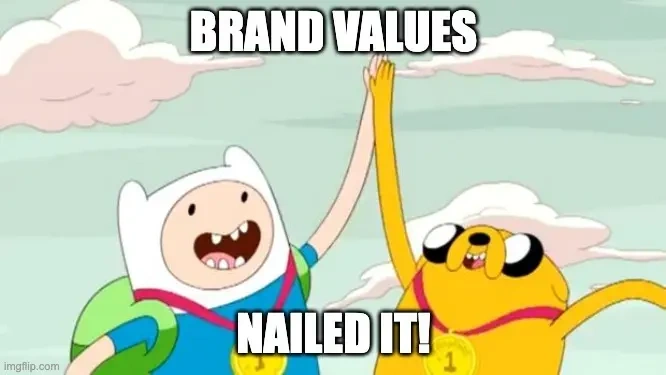
The greatest stories have a wider arc running beneath their stand-alone tales. In each episode, Jake and Finn seemingly jump from one adventure to the next. From rescuing a gang of raving bears from the belly of a beast to becoming Marceline the Vampire Queen’s reluctant henchman, plenty of Adventure Time’s episodes seem to stand alone.
But beneath the quirky one-off stories, Adventure Time is tied together by an overarching theme: Finn and Jake are heroes determined to fulfil their heroic duty by offering their help to whoever acquires it across the land of Ooo. Finn and Jake have a personal code of ethics that gives meaning to their lives which resonates with their audience and sparks each of their episodic adventures.
In comparison, if you don’t have clearly defined values, your customers can’t get behind you as a brand because there’s nothing to connect to beyond the surface level.
The smartest brands don’t tell fragmented, stand-alone brand experiences that only fuzzily correlate to one another in style or characteristics. Instead, they offer an overarching arc in the form of clearly defined, driving goals or values.
To nail your brand story, you need to nail your values. When creating your brand story, answer these questions:
1. What are your values as a company? Do you have a philosophy or code of conduct that can help humanize your brand to your audience?
2. How can you personify these values? How can you add depth and color to these values? How can you express them in a creative and engaging way to your audience?
3. What inspires you and the work you do? Simon Sinek says that people don’t care about what you do, only why you do it. Your why is defined as your purpose and reason for existing as a company.
4. How are you connected to wider society? As an example, do you donate to charities that are in line with your brand values?
#2 Give your brand stories guts and heart (aka don’t shy away from talking about your challenges)
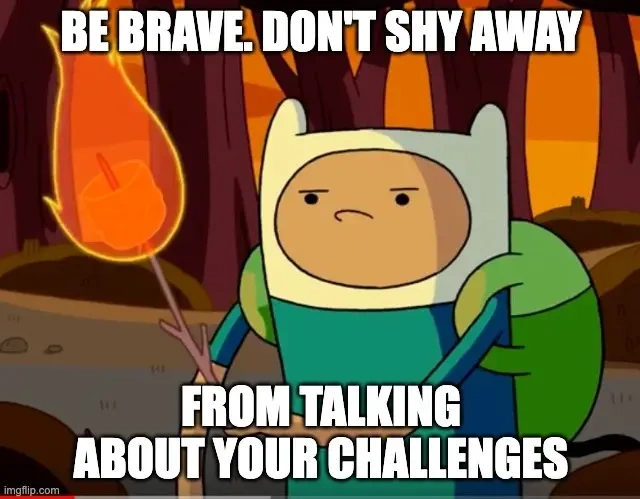
We all love a gutsy story. Emotionally rich. One that’s full of unexpected plot twists. In contrast, a safe or ‘cowardly’ story is one where you can predict exactly what’s going to happen next.
In your average kids’ cartoon, the hero saves the helpless right at the last moment, they are often rewarded for their deeds, and the adventure is wrapped up with a wholesome moral.
In Adventure Time, good doesn’t always beget good. Finn regularly comes up against unexpected challenges that also shake his beliefs and moral compass, something many of us marketers can relate to. The latest reports show that Instagram has a damaging impact on girls' mental health, with 32% saying it made them feel worse about their bodies. While Facebook whistleblower Frances Haugen, in her testimony before the US Senate, argues that, “Facebook’s products harm children, stoke division and weaken our democracy — they have put their astronomical profits before people.” Facebook and Instagram are huge revenue drivers for many brands, but many marketers are now struggling with the question: is it ethical to continue to advertise on these platforms?
Finn also struggles to untangle his own moral dilemmas. In one Adventure Time episode, in an attempt to fulfill his self-imposed moral code to help everyone who needs it, Finn rescues gnomes from a lake of fire. However, once they’re free, they begin blowing up old ladies. The more Finn begs them to stop, the more old ladies they destroy.
Jake helps Finn out by putting the gnomes back in the lake, he then tells Finn that you can’t always trust yourself to tell the good guys from the bad. Finn’s naivete in assuming he’ll be able to tell who he should save and will be rewarded for his heroism is something he must grapple with throughout his adventures.
This unexpected twist, where good doesn’t always lead to good and that the hero doesn’t always know best, gives Adventure Time an unpredictable element that raises the emotional stakes.
Most kids’ cartoons fall victim to tired cliché storytelling based on shallow moral fables that make them all-too predictable. In a similar vein, Jane Hope writes that ‘cowardly storytelling’ is many brand stories biggest downfall:
“There can be a reticence on the part of companies to avoid talking about anything perceived to be unpleasant. This cowardly approach to storytelling never works.”
“Often, when working on book projects, clients tell us, ‘We did a book twenty years ago, and nobody liked it.’ When we get a copy of this much-maligned book, we realize that the “story” is a dry recitation of facts in lieu of using storytelling to explain how a company grew and developed. That’s why nobody liked it.”
Being afraid to embrace anything unpleasant or complex is a key ingredient of what makes a story emotionally complex and exciting. As HubSpot argues, stories are about overcoming adversity, giving people a dramatic challenge to relate to – and the best stories do this in a unique way.
Don’t tell boring brand tales, where the hero saves the needy in the nick of time and is always correct in their assessment of good vs evil and right vs wrong. Instead, embrace your flaws and challenges and demonstrate how you’ve dealt with them:
1. What obstacles have you overcome and how have they enriched your philosophy and values as a company?
2. What are your flaws?
3. How can you connect to your audience by exploring your flaws in your brand story, showing you that you’re down-to-earth and genuine?
#3 Create emotional resonance with complex characters (aka don’t fall into boring business speak)
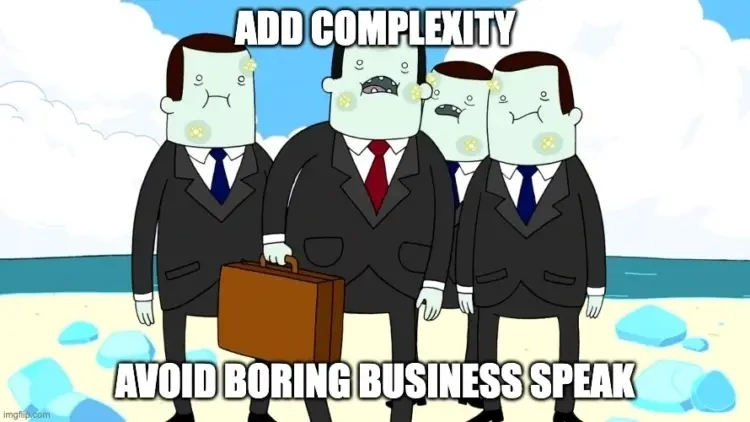
Emotionally complicated and intriguing characters elevate stories. Well-crafted characters trigger mirror neurons in the brain. You can easily empathize with what someone else is feeling because of mirror neurons. Mirror neurons create the same emotional state in your own brain. Emotionally rich and layered characters create a deep sense of emotional resonance for the audience, triggering your mirror neurons, and helping you form a connection with the leading protagonists.
All the characters in Adventure Time are intriguing, complex, and evoke empathy—the glue that keeps viewers connected to the characters and their stories each episode. Adventure Time’s main villain has an unexpected depth. Ice King doesn’t steal princesses purely because he’s evil, but because he’s sad and lonely and can’t find love.
In contrast, Marceline the Vampire Queen is introduced as a tough, mischievous character that’s later revealed to have a sad past and troubled relationship with her dad. While Finn’s sidekick Jake is both loyal and supportive and impulsive and eccentric. Both aspects of Jake’s personality draw him into his adventures with Finn and help them defeat their foes and obstacles.
If you want to develop an awesome brand story, you need to create empathy-evoking, rich characters.
When it comes to your brand story, your central character is often your audience. But it can also be your brand voice. Many brands, especially in the B2B niche, take on a bland, business-speak tone of voice that fails to connect with their audience. You can remedy this by envisioning your brand voice as a multi-faceted, intriguing character worthy of an Adventure Time cameo.
For example, many of the biggest brands base their distinctive brand voice on classic story archetypes. Nike’s brand voice is based on the ‘hero archetype’, brave and self-confident, pushing for a better world – similar to Finn.
To master a killer brand voice, Copyhackers recommends that brands take on a character whenever they write their copy. Think a leather-clad, bearded biker talking up a healthy whole foods brand. The most effective brand voices are based on characters that break out of their typical niche, such as a slang-heavy, obscenity-loving Grandma selling knitting kits–something totally unexpected for that kind of company.
#4 Your audience is Finn, your company is Jake (aka embrace the sidekick role)
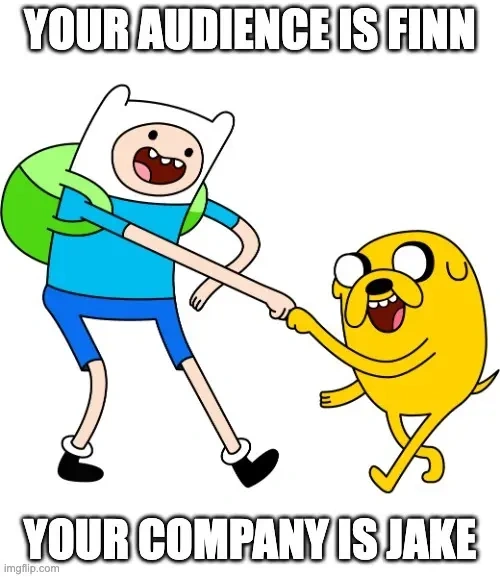
Many brands go wrong when they make their company the hero of their story. Self-absorbed storytelling, focused on why your brand is so great, won’t hold your audience’s interest.
Beyond your brand voice, your customer should also be your central character or hero. The hero in the story has a mission they want to achieve – just like Finn and his hero’s oath. Alongside the hero, great stories also have supporting characters or sidekicks. Jake uses his ingenuity, creative thinking, worldly wisdom, and shape-shifting magic to help Finn on his missions.
Just like Jake, your brand should serve as a sidekick, offering the support your hero (the customer) needs to achieve their desired goals:
1. What kind of transformation is your customer looking for? Maybe they want to get fitter, make more money, or to master a new skill?
2. How will your brand help them achieve their goal?
3. Which unique character traits will you use to help them accomplish their task? How can you demonstrate your unique value as a brand?
#5 Delight your audience with the unexpected (aka don’t be afraid to be weird)
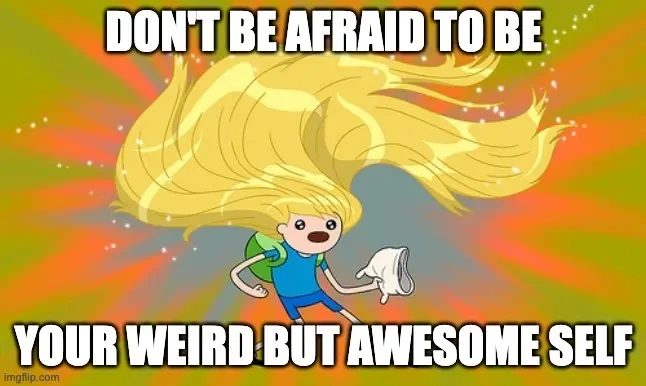
In our introduction, we highlighted how the best brand stories go beyond providing a product or service and offer an, “Experience that transcends mundane reality.”
But how can you create an exceptionally emotional experience if you play it safe with your brand story?
One of the main reasons Adventure Time became a cult classic was because it wasn’t afraid to embrace the weird. From Lumpy Space princesses to businessmen frozen in blocks of ice, Adventure Time isn’t your everyday kids’ cartoon. Most kids’ cartoons play it safe with cookie-cutter, seen-them-before characters, and a familiar wholesome vibe.
As Time Magazine argues, Adventure Time’s episodes, ‘Lemonhope Part 1 and 2,’ perfectly illustrate its “dreamy, freaky-cool surrealism”, emotional spectrum, and quirky characters and storylines.
Young Lemonhope, a lemon child who has escaped the totalitarian regime of the Lemon Kingdom, tries to outrun his calling as the hero of his enslaved people. He suffers a series of mind-bending nightmares about his past and his kingdom. First resisting his destiny, the musical Lemonhope uses his harp to defeat the dictator of the Lemon Kingdom.
From the mind-twisting dreams to the way the unlikely hero inventively defeats the bad guy, this episode encapsulates Adventure Time’s quirky, mind-warping fun at its best.
Just like your everyday uninventive kids’ cartoon, most companies play it safe with their brand story. But this approach can be a snoozefest for their audience. From not taking risks with your image choices to using dry marketing speak in your emails, social media ads, and web copy – if you’re not taking risks, you probably aren’t doing enough to break your audience out of their inertia so they can fully engage with your brand.
As Joanna Wiebe notes, inertia is the natural inclination people have to stay comfortable, protect their energy, and resist doing anything different from what they are doing now. Wiebe says, “Your prospect has to be jolted out of inertia, or its path at least, by a force stronger than it.”
To create a strong emotional pull, you have to play, experiment, and break away from the typical brand stories seen in your niche.
What does an imaginative brand story look like in action? Unlike your standard card game, Cards Against Humanity’s brand story can be defined by an off-beat, offensive sense of humor and delight in mayhem. The tagline alone: “A card game for horrible people,” highlights the fun their card-playing customers could have by ordering their own pack for their next dinner party.
Death to boring brand stories
Just like Adventure Time, your brand story doesn’t have to go down the same cliché route as your competitors. Create a memorable brand story by surprising your audience, nailing your brand values, playing sidekick, and crafting awesome characters.
Want more in-depth content? Join our newsletter subscribers by clicking the banner below, and then navigating to the chat icon on the bottom right hand corner of your screen.















